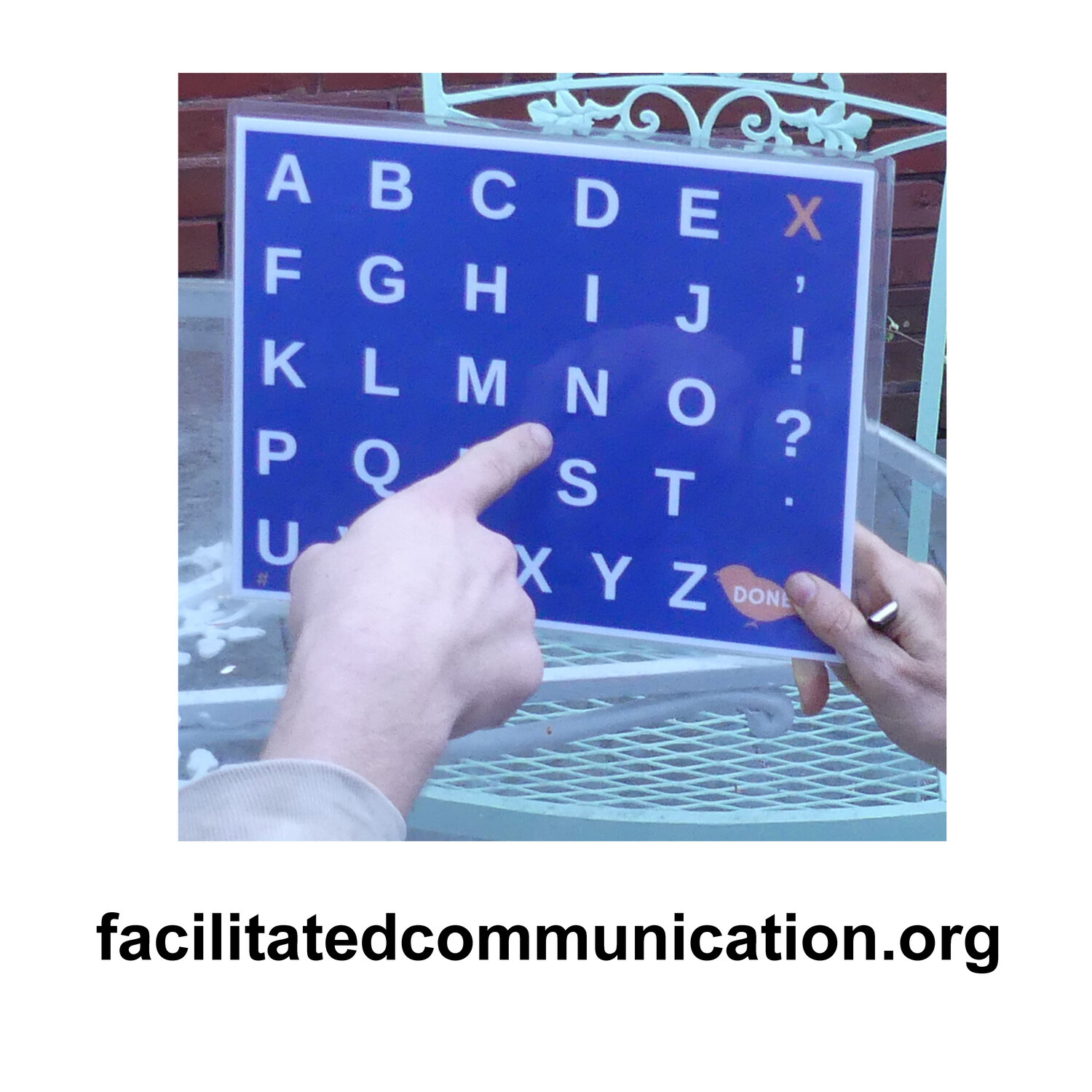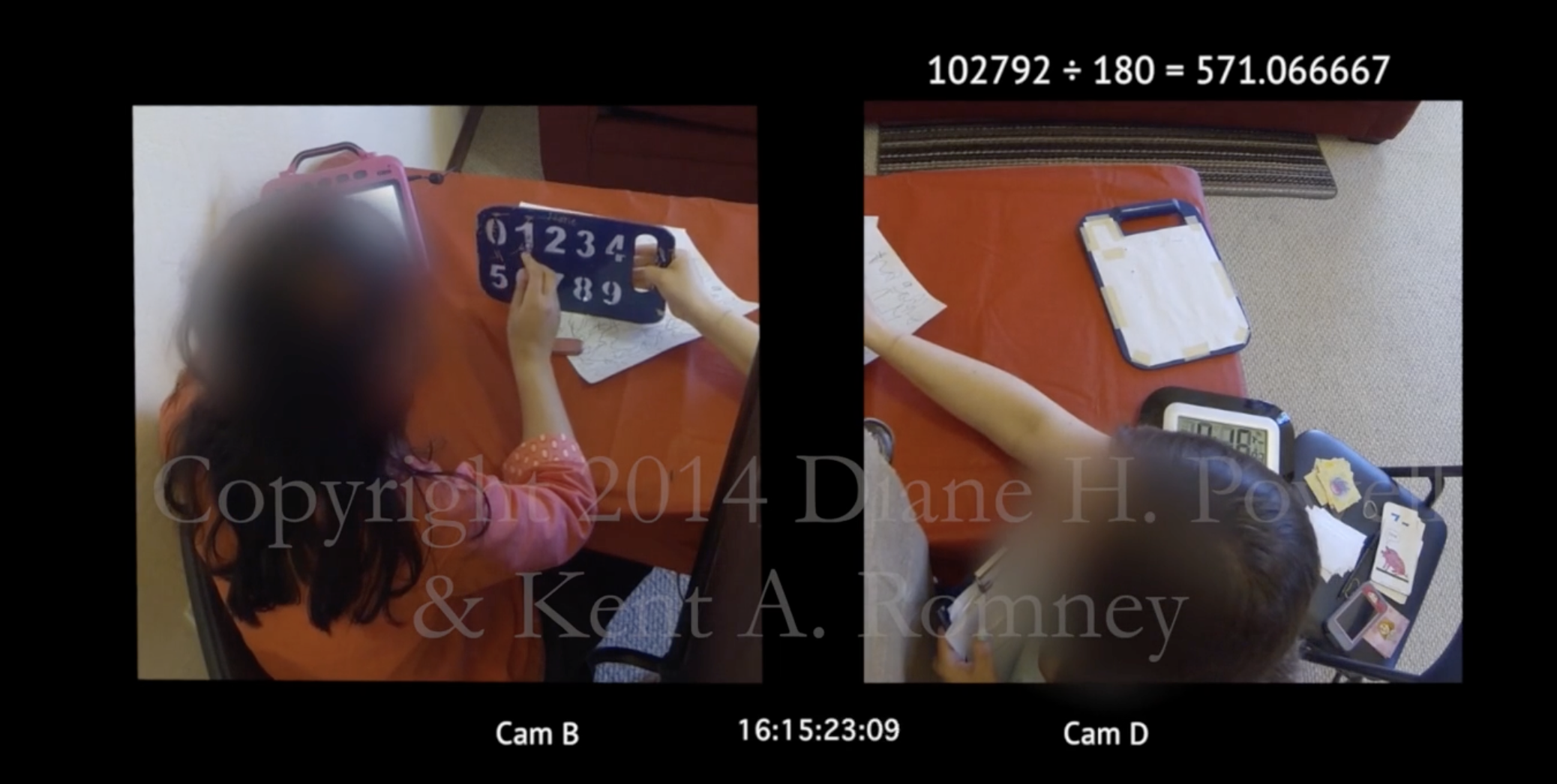Jefferson Public Radio on “Medford psychiatrist’s research into autism and telepathy sparks debate over communication”
Continuing my closer look at some of the news items from our recent news roundup, I now turn to a May 2nd piece on Jefferson Public Radio entitled Medford psychiatrist’s research into autism and telepathy sparks debate over communication. This new item showcases Johns Hopkins-trained psychiatrist Dr. Diane Powell, whose name should be familiar to anyone familiar with the Telepathy Tapes as the Telepathy Tapes’ star, pro-telepathy scientist.
Here Haley is being subjected to a form of FC called “spelling to communicate” (S2C). In this test, the facilitator is shown a number, then holds a stencil in the air and controls access to it while Haley pokes at the stencil with a pencil. Reliably controlled testing of FC consistently shows that facilitators, not their clients, are controlling letter/number selection through visual, auditory and/or physical cueing. Often facilitators are unaware of the extent to which they cue their clients. If this was a reliably controlled test for telepathy (or for authorship in FC), the facilitator would be blinded from seeing the target numbers to make sure they were not influencing letter/number selection in any way. (Image from “"Sample Telepathy Video Clips copyright 2014 Diane H. Powell and Kent A. Romney”)
While the article’s focus is on Powell and on how she came to believe that non-speakers are telepathic, it is also, necessarily, an article about RPM/S2C. That’s because a video-taped RPM/S2C session that Dr. Powell has “watched countless times” is part of what convinced her—or so journalist Justin Higginbottom suggests. As he describes it:
On the screen is Haley, a nonverbal child with autism, sitting next to a therapist. Across the room, her mother lifts a card off the table, showing the image on it — a triangle — to the camera, but not to Haley.
The therapist, holding an electronic letter board that resembles an iPad, asks Haley to spell what’s on the card.
Slowly, Haley taps out the answer.
She presumably types out “triangle,” which is correct.
“You can see the therapist is not moving this device,” Powell noted.
Haley repeats the feat over and over again, slowly typing out words that match the image on the cards.
Like the January 10th Disability Scoop piece (see here), this piece does acknowledge the controversy surrounding RPM/S2C:
The debate comes down to that therapist in Powell’s video holding the letterboard while Haley spells out words. Supporters say it’s a breakthrough for many with autism. Critics say it’s a red flag.
And Higginbottom even goes so far as to speak, at length, with one of the directors of the American Speech-Language-Hearing Association (ASHA)—something that very few journalists covering RPM/S2C in the popular media have bothered to do:
“Spelling is not the issue. It's doing it independently,” said Jaime Van Echo, associate director of clinical issues at the American Speech-Language-Hearing Association (ASHA).
The organization is generally against communication practices involving heavy assistance from another person. That could be someone touching the nonverbal individual’s arm, prompting them in certain ways or even holding a letterboard in front of them.
“The main difference here is that… they're holding the board, which means that the other person, who's the independent communicator, is communicating with the support of another person,” Van Echo said. “And what ASHA really does strive for is independent communication.”
Someone using a letter board that’s lying on a table is perfectly fine, according to Van Echo. But problems may arise, according to ASHA, when someone else is involved in the conversation.
It might seem like a small distinction. But the group has gone as far as saying another assisted practice, called the Rapid Prompting Method, “effectively strips people of their human right to independent communication.” The organization has spoken out against teaching a similar method, called Spelling to Communicate, in schools.
But then Higginbottom, who is clearly striving for “balance,” returns to the pro RPM/S2C side:
But proponents of these assisted methods argue many with severe autism struggle with motor skills or focus. Without assistance, they say, the opportunity to communicate may be lost.
This is something he could have run past Van Echo at ASHA; if he had, he would have learned that claims about difficulties with motor skills or focus don’t validate FC/RPM/S2C.
Worse, Higginbottom takes on faith a claim made in Heyworth et al.’s highly problematic Presuming Autistic Communication Competence and Reframing Facilitated Communication article:
A 2022 Frontiers in Psychology article cited more than 100 peer-reviewed studies confirming people with autism are the ones communicating while using assisted methods.
If you read that article carefully, you see that it simply states that “peer-reviewed studies confirming autistic or disabled authorship of FC messages number over a hundred from the 1990s to the present” and then cites an article by Cardinal and Falvey (2014). If you chase down that footnote, you find that Cardinal and Falvey, in turn, state, without any supporting citations, that:
Since the inception of FC, well over 100 qualitative articles have been published in professional peer-reviewed journals, as compared with around 40 for quantitative studies.
One of my colleagues tried contacting both Cardinal and Falvey and asking them for a reference; she received no response.
Extraordinary claims like these require extraordinary evidence, and in Cardinal and Falvey’s citations, which number less than 80, there are, at most, 13 studies that could possibly qualify as peer-reviewed studies finding some weak support for (and not coming close to confirming) autistic or disabled authorship of FC messages. In general, as Scott Lilienfeld has said, there is an inverse relationship between study rigor and support for FC/RPM/S2C.
Apparently not realizing this, Higginbottom goes on to cite the highly problematic pro-S2C organization International Association for Spelling as Communication (I-ASC) and its citation of the highly problematic Jaswal et al. (2020) eye-tracking study.
The International Association for Spelling as Communication cites a study that tracked the eye movements of non-verbal individuals. It found that they appeared to focus on the correct letters before selecting them — proof that people with autism, not their aides, are the ones communicating.
No, “appearing to focus on the correct letters before selecting them” is not “proof” that the people being subjected to FC/RPM/S2C are the ones communicating (for details, see critiques here and here).
But then Higginbottom returns to the FC/RPM/S2C critics:
But other researchers disagree. A 2001 meta-analysis published in the Journal of Autism and Developmental Disorders reviewed studies on a related method known as Facilitated Communication. It found the facilitators, rather than the nonverbal individuals, were controlling communication.
In the end, though, “balance” wins out:
So, it’s safe to say that the science around this debate isn’t settled.
Actually, the science is quite settled, and all those instances of alleged telepathy that both Dr. Powell and the Telepathy Tapes podcast have compiled for us, the non-paranormal explanation for which is facilitator control, only settle it further.
Worse, the article captions one of its pictures with this:
Some have found success in using letter boards to communicate with people with severe autism.
Technically, “find success” is ambiguous: the success could be an illusion. But this is also a stand-out sentence: one that is sure to grab the attention of, and stick in the minds of the many people who won’t read the full article.
Returning to Powell and telepathy, Higginbottom does note that:
Although the Telepathy Tapes and Powell’s work have led to more parents learning about their method or similar systems, advocates think being associated with mind reading is hurting their efforts to gain wider acceptance for assisted communication.
In that last excerpt, Higginbottom links to the statement on telepathy by the International Association for Spelling as Communication (I-ASC). For those who are interested, here’s what Vosseller & Co have to say about telepathy:
I-ASC does not integrate or endorse telepathy or other such personal beliefs as part of S2C. Introducing such concepts into S2C compromises the integrity [sic] and credibility of this rigorously defined [sic] methodology.
Recent public discussions linking telepathy to nonspeaking individuals and S2C risk creating misunderstandings about the practice. I-ASC emphasizes that telepathy is outside the scope of S2C and unrelated to its science-based [sic] approach.
One can only hope that telepathy is hurting I-ASC’s efforts to gain wider acceptance.
But Higginbottom ends with a different sort of hope, or “hope.” In a concluding section entitled “Hope for Parents,” he tells us about a non-speaking girl who, at age 10, “gained a limited ability to speak.” She, too, is apparently telepathic, but her telepathy has expressed itself through speech; not S2C. Her mother reports that she was once:
deciding whether to pack a grapefruit in her daughter’s lunch, and Ginny — unprompted — yelled “grapefruit" from another room.
Yet, for all this, the mother wants to switch from speech to S2C:
But she has trouble communicating with her daughter — even with the mind reading. That’s why she wants to teach her to use a letterboard.
Higginbottom continues:
As Dr. Powell explains, the beliefs that “her daughter is in there” and that she has “far more capacity than people give [her] credit for”—beliefs that Powell appears to share—“is why her research resonates with so many parents.”
Indeed—as with so much of other autism quackery, so, too, with S2C and telepathy.
REFERENCES
Beals, Katharine (2021, May 12). A Recent Eye-Tracking Study Fails to Reveal Agency in Assisted Autistic Communication. Evidence-Based Communication Assessment and Intervention, DOI: 10.1080/17489539.2021.1918890
Cardinal, D., & Falvey, M. (2014). The Maturing of Facilitated Communication: A Means Toward Independent Communication.
Research and Practice for Persons with Severe Disabilities, 39:3, 189-194. 10.1177/1540796914555581
Heyworth, M., Chan, T., & Lawson W. (2022). Presuming autistic communication competence and reframing facilitated communication. Frontiers in Psychology.
Jaswal, V.K., Wayne, A. & Golino, H. (2020) Eye-tracking reveals agency in assisted autistic communication. Scientific Reports 10, 7882. DOI: 10.1038/s41598-020-64553-9
Vyse, Stuart. (2020, May 20). Of Eye Movements and Autism: The Latest Chapter in A Continuing Controversy. Skeptical Inquirer.


